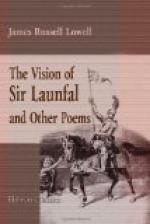198. The first American: In a prose article, Lowell calls him “The American of Americans.” Compare Tennyson’s “The last great Englishman,” in the Ode on the Death of the Duke of Wellington. Stanza IV of Tennyson’s ode should be compared with this Lincoln stanza.
202. Along whose course, etc.: Along the course leading to the “inspiring goal.” The conjunction of the words “pole” and “axles” easily leads to a confusion of metaphor in the passage. The imagery is from the ancient chariot races.
232. Paean: A paean, originally a hymn to Apollo, usually of thanksgiving, is a song of triumph, any loud and joyous song.
236. Dear ones: Underwood says in his biography of Lowell: “In the privately printed edition of the poem the names of eight of the poet’s kindred are given. The nearest in blood are the nephews, General Charles Russell Lowell, killed at Winchester, Lieutenant James Jackson Lowell, at Seven Pines, and Captain William Lowell Putnam, at Ball’s Bluff. Another relative was the heroic Colonel Robert G. Shaw, who fell in the assault on Fort Wagner.”
As a special memorial of Colonel Shaw, Lowell wrote the poem, Memoriae Positum. With deep tenderness he refers to his nephews in "Mr. Hosea Biglow to the Editor of the Atlantic Monthly":
“Why, hain’t I
held ’em on my knee?
Didn’t I
love to see ’em growin’,
Three likely lads ez wal could
be,
Hahnsome an’
brave an’ not tu knowin’?
I set an’ look into
the blaze
Whose natur’,
jes’ like theirn, keeps climbin’,
Ez long ‘z it lives,
in shinin’ ways,
An’ half
despise myself for rhymin’.
“Wut’s words to
them whose faith an’ truth
On War’s
red techstone rang true metal,
Who ventered life an’
love an’ youth
For the gret prize
o’ death in battle?
To him who, deadly hurt, agen
Flashed on afore
the charge’s thunder,
Tippin’ with fire the
bolt of men
Thet rived the
Rebel line asunder?”
243. When Moses sent men to “spy out” the Promised Land, they reported a land that “floweth with milk and honey,” and they “came unto the brook of Eshcol, and cut down from thence a branch with one cluster of grapes, and they bare it between two upon a staff; and they brought of the pomegranates and of the figs” (Numbers xiii.)
245. Compare the familiar line in Gray’s Elegy:
“The paths of glory lead but to the grave.”
and Tennyson’s line, in the Ode to the Duke of Wellington:
“The path of duty was the way of glory.”
In a letter to T.W. Higginson, who was editing the Harvard Memorial Biographies, in which he was to print the ode, Lowell asked to have the following passage inserted at this point:




